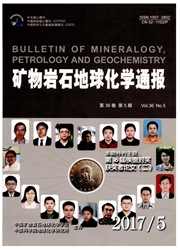

 中文摘要:
中文摘要:
黄铁矿热电系数的研究成果较多,但其测试的活化温度(温差条件)通常不统一,不同活化温度对热电系数的影响也不甚清楚。本文首先介绍了黄铁矿热电系数的原理,区分了导电类型、热电结构类型与热电场类型三个易混淆的概念;讨论了黄铁矿热电系数的测试方法,并对其热电系数与活化温度的关系进行了实验研究,结果显示黄铁矿热电动势绝对值总体随活化温度的升高而增大,但热电系数绝对值大致随活化温度的升高而降低;活化温度对P型黄铁矿热电系数特征的影响要比对N型黄铁矿热电系数特征的影响明显。通过对比分析,认为用BHTE-06型热电系数测量仪测试黄铁矿热电系数时,活化温度选取40℃更为合适。
 英文摘要:
英文摘要:
There are many literatural studies about thermoelectric coefficient of pyrite,but the activation temperatures in the studies are usually various.Therefore,the effect of the activation temperature to the thermoelectric coefficient remains ambiguous.This paper introduces the theory of thermoelectric coefficient,and distinguishes the easily confused conceptions of conduction type,type of thermoelectric structure and thermoelectric field type of pyrite.The paper reviews the methods of measuring thermoelectric coefficient of pyrite,and systematically studies the correlation of the thermoelectric coefficient of pyrite and the activation temperature.The result indicates that the absolute value of thermo-electromotive force increases and the absolute value of thermoelectric coefficient decreases as the activation temperature rises,and that the activation temperature has more significant effect on the thermoelectric coefficient of P-type pyrite than on that of N-type pyrite.According to our experiments results,we conclude that the most appropriate activation temperature is 40℃ for using BHTE-06 type instrument to measure the thermoelectric coefficient of pyrite.
 同期刊论文项目
同期刊论文项目
 同项目期刊论文
同项目期刊论文
 Discovery and geological significance of telluride minerals in the Yinggezhuang gold deposit, Rushan
Discovery and geological significance of telluride minerals in the Yinggezhuang gold deposit, Rushan Low-Al and high-Al trondhjemites in the Huai'an Complex, North China Craton: Geochemistry, zircon U-
Low-Al and high-Al trondhjemites in the Huai'an Complex, North China Craton: Geochemistry, zircon U- Stable isotopes and noble gases in the Xishimen gold deposit, central North China Craton: metallogen
Stable isotopes and noble gases in the Xishimen gold deposit, central North China Craton: metallogen Mesozoic magmatism and metallogenesis associated with the destruction of the North China Craton: Evi
Mesozoic magmatism and metallogenesis associated with the destruction of the North China Craton: Evi Source characteristics and fluid evolution of the Beiyingxigou Pb-Zn-Ag deposit, central North China
Source characteristics and fluid evolution of the Beiyingxigou Pb-Zn-Ag deposit, central North China Charateristics of the genetic mineralogy of pyrite and its significance for the prospecting in the D
Charateristics of the genetic mineralogy of pyrite and its significance for the prospecting in the D Laser probe 40Ar-39Ar dating for quartz from auriferous quartz veins in the Shihu gold deposit, west
Laser probe 40Ar-39Ar dating for quartz from auriferous quartz veins in the Shihu gold deposit, west The Beiminghe skarn iron deposit, eastern China: Geochronology, isotope geochemistry and implication
The Beiminghe skarn iron deposit, eastern China: Geochronology, isotope geochemistry and implication THERMOLUMINESCENCE (TL) ANALYSIS FOR OTOLITHS OF THE WILD CARPS (CYPRINOID) FROM BAIYANGDIAN LAKE AN
THERMOLUMINESCENCE (TL) ANALYSIS FOR OTOLITHS OF THE WILD CARPS (CYPRINOID) FROM BAIYANGDIAN LAKE AN Significance of zircon trace element geochemistry, the Shihu gold deposit, western Hebei Province, N
Significance of zircon trace element geochemistry, the Shihu gold deposit, western Hebei Province, N ISOTOPE GEOCHEMISTRY OF THE SHIHU GOLD DEPOSIT, HEBEI PROVINCE, NORTH CHINA: IMPLICATION FOR THE SOU
ISOTOPE GEOCHEMISTRY OF THE SHIHU GOLD DEPOSIT, HEBEI PROVINCE, NORTH CHINA: IMPLICATION FOR THE SOU Geochronology and petrogenesis of Neoarchean potassic meta-granites from Huai';an Complex: Implicati
Geochronology and petrogenesis of Neoarchean potassic meta-granites from Huai';an Complex: Implicati Laser Ablation ICP-MS U-Pb Zircon Geochronology of Granitoids and Quartz Veins in the Shihu Gold Min
Laser Ablation ICP-MS U-Pb Zircon Geochronology of Granitoids and Quartz Veins in the Shihu Gold Min Geodynamics of gold metallogeny in the Shandong Province, NE China: An integrated geological, geophy
Geodynamics of gold metallogeny in the Shandong Province, NE China: An integrated geological, geophy Oxygen, boron, chromium and niobium enrichment in native Au and Ag grains: A case study from the Lin
Oxygen, boron, chromium and niobium enrichment in native Au and Ag grains: A case study from the Lin Magmatism and metallogeny associated with mantle upwelling: Zircon U-Pb and Lu-Hf constraints from t
Magmatism and metallogeny associated with mantle upwelling: Zircon U-Pb and Lu-Hf constraints from t Metallogeny in response to lithospheric thinning and craton destruction: Geochemistry and U-Pb zirco
Metallogeny in response to lithospheric thinning and craton destruction: Geochemistry and U-Pb zirco Geochemistry, and zircon U-Pb and molybdenite Re-Os geochronology of Jilongshan Cu-Au deposit, south
Geochemistry, and zircon U-Pb and molybdenite Re-Os geochronology of Jilongshan Cu-Au deposit, south 期刊信息
期刊信息
